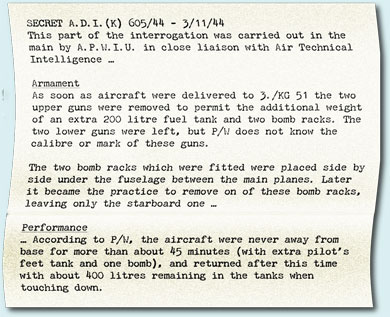
|
In operating jet aircraft (Me 163, Me 162, Ar 234) every step is to be taken to ensure that in no circumstances does any of these aircraft fall into enemy hands. Therefore until further notice they are not be deployed beyond our own lines or, when over water, less than 50 km from the enemycoast. The ground organisation for these aircraft is to be selected so that is secure against hostile advances in the event of an unexpected development in the ground situation. Luftwaffe Führungsstab contingency planning for an invasion in the West
According to a captured Austrian mechanic, a convoy of lorries arrived at Lechfeld on 17 July 1944 and loaded up him and his comrades in 3./KG 51’s ground echelon. After seven nights on the road they reached Châteaudun, about 110 km. south west of Paris, where they were employed in repairing bomb damage and other manual labour until mid-August. They then travelled the 200 km. by road to Creil (45 km. north west of the French capital) for more such work before being transferred 120 km. eastward to Juvincourt-et-Damary on the night of the 18/19th. Next morning, five Me 262s flew in and as the prisoner related, flew 4–5 sorties daily from then on. Two aircraft were said to have been lost: the first force-landing between its base and the front line (the pilot not being seen again), the other being wrecked in a landing accident after its nose wheel tyre burst. Here the Austrian’s memory for dates definitely goes awry for he says that on the 23rd the Kommando moved to Chièvres and that one aircraft was lost en route to unknown causes. Deciphered signals reveal that the unit was due to relocate to the Belgian airfield on 29 August but did not in fact do so; on the other hand, one of its Me 262s was shot down over Belgium on the 28th. The Me 262’s arrival in France had been expected since the first days of the Invasion. On 9 June 1944, Luftflotte 3 asked Berlin what the type’s operational requirements were and received a reply the following evening: – a landing area 1500 x 400 metres with 50 m. reinforced strips on either side – permanent taxi tracks of 12 m. – minimum obstacle clearance of 1:70 (and 1:100 if possible) – a “supplementary fuel installation” of 300 cbm which 100 cbm should be near the take-off point The aircraft itself was said have a span of 13 m. and to be 12 m. long and 3 m. high.
On 22 June the Luftwaffe Chief of Staff ordered that three Me 262 bomber Schwärme (12–15 aircraft in all) be placed at the General der Kampfflieger’s disposal as soon as possible. A like number of crews—whether service personnel, civilians, engineers or officers did not matter— should be trained for the operation and dispatched to France. Once there they would be subordinated to IX. Fliegerkorps. They would be led by Major Schenck of KG 51 and warships, primarily cruisers and destroyers, were their intended target. continued on next page…
|
||||||||
PART ONE OF SiX This article covers the preparations for the deployment of the Me 262 bomber on the Western Front and one week — possibly the first — in the operational life of Einsatzkommando KG 51 which saw its withdrawal from France to Holland. The information here is drawn from the files of the British Government Code & Cipher School, the Bundesarchiv-Militärarchiv, a report by the Air Prisoner of War Interrogation Unit of 2 TAF on an Austrian mechanic who deserted from 3./KG 51 and the Air Ministry Intelligence file on Junkers turbo-jets. I will also make some comparisons with what has been said in books by Wolfgang Dierich, J. Richard Smith & Eddie J. Creek, Jan Horn and Manfred Jurleit. All times are GMT. ©Nick Beale 2008–2024 |
|||||||||

